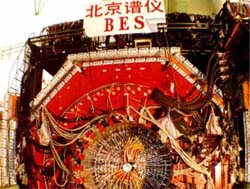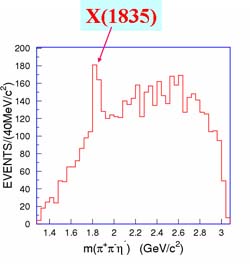

An international research consortium announced on January 6 the observation of a resonant state at the upgraded Beijing Spectrometer (BESII). The discovery, which was reported in the Dec. 31, 2005 Issue of the
Physical Review Letters, has aroused a broad interest from the high-energy physics community in the world.
The new particle, which is named as X1835 (X means an unknown structure) for the time being, was discovered in J/ψ decay to one photon and three mesons on the analysis of 58 million J/ψ events. With a mass of 1835 MeV, the new particle is very short-lived, only existed about 10¯²³ seconds.
Scientists expect the X1835 might be a new particle they have cast about for several decades. Particle physicists are making various speculations on its basic structure. However, according to researchers, the final identification can not be made unless even more data are available and in-depth experimental and theoretical studies are carried out.
The BES is a large-scale, general-purpose solenoidal detector installed on the Beijing Electron Positron Collider (BEPC) on the campus of the CAS Institute of High Energy Physics (IHEP). The BES International Collaboration, which is composed of the physicists and graduate students from IHEP and 20 other universities and research institutions from home and abroad, is dedicated to the study of tau lepton and charm quark physics. J/ψ particle, a composite of charm quark and anti-charm quark, was discovered simultaneously at the Brookhaven National Laboratory and the Stanford Linear Accelerator Center in the United States in 1974 by Prof. S.Ting and Prof. B.Richter who were awarded the Nobel Prize for the discovery. The study of J/ψ decays provides physicists an ideal laboratory for the study of light hadron spectroscopy and charm physics.
Scientists say that more detailed studies will be made on the X1835 and other recent discoveries at BES in 2007 when a major upgrade on both BEPC and BES is completed with a significant improvement in their performance and much larger numbers of J/y events collected.








